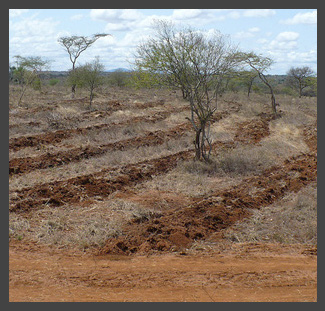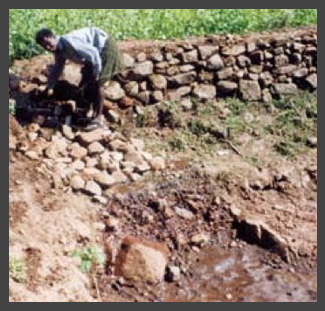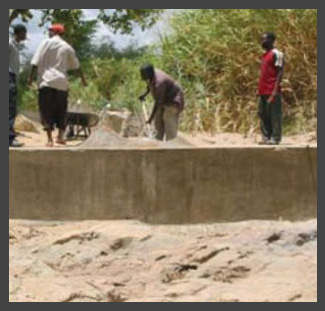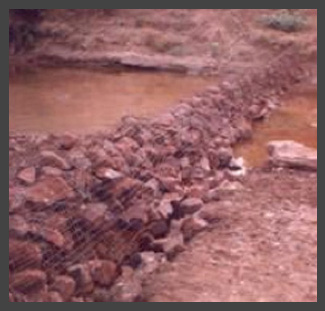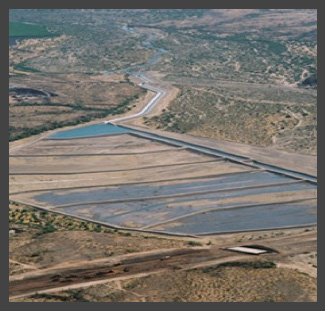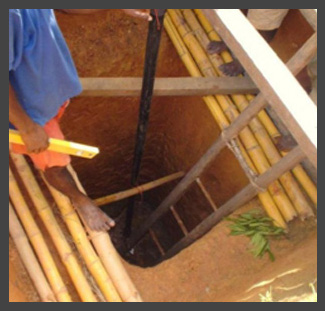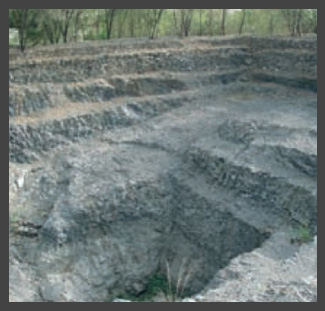Difference between revisions of "La recharge des eaux souterraines"
From Akvopedia
(→Recharge des eaux souterraines : liens) |
|||
| (21 intermediate revisions by 2 users not shown) | |||
| Line 1: | Line 1: | ||
| − | {{Language-box|english_link=Groundwater recharge | + | {{Language-box|english_link=Water Portal / Rainwater Harvesting / Groundwater recharge |french_link=La recharge des eaux souterraines |spanish_link=Recarga de acuiferos |hindi_link=वाटर पोर्टल / वर्षाजल संचयन / भूजल पुनर्भरण |malayalam_link=Coming soon|tamil_link=Coming soon | korean_link=Coming soon | chinese_link=地下水回灌 | indonesian_link=Panen Air Hujan / Pengisian ulang air tanah | japanese_link=地下水涵養 }} |
La recharge des eaux souterraines naturelles est améliorée par des réalisations humaines telles que des bassins d’infiltration, des fossés, des tranchées, des barrages ou encore des puits d’injection. La recharge et le stockage de l’aquifère (ASR) est un type spécifique de recharge des eaux souterraines visant à l’accroissement des ressources en eaux souterraines et à leur renouvellement dans le futur pour divers usages. | La recharge des eaux souterraines naturelles est améliorée par des réalisations humaines telles que des bassins d’infiltration, des fossés, des tranchées, des barrages ou encore des puits d’injection. La recharge et le stockage de l’aquifère (ASR) est un type spécifique de recharge des eaux souterraines visant à l’accroissement des ressources en eaux souterraines et à leur renouvellement dans le futur pour divers usages. | ||
<small-title /> | <small-title /> | ||
| Line 14: | Line 14: | ||
|colspan="5" style="background-color:#efefef;"| | |colspan="5" style="background-color:#efefef;"| | ||
|- | |- | ||
| − | |style="background:#efefef;"|[[Image:infiltration ponds small.jpg|center|100px|link=Infiltration ponds]] | + | |style="background:#efefef;"|[[Image:infiltration ponds small.jpg|center|100px|link=Water Portal / Rainwater Harvesting / Groundwater recharge / Infiltration ponds]] |
| − | |style="background:#efefef;"|[[Image:contour trench small.jpg|center|100px|link=Contour trenches]] | + | |style="background:#efefef;"|[[Image:contour trench small.jpg|center|100px|link=Water Portal / Rainwater Harvesting / Groundwater recharge / Contour trenches]] |
| − | |style="background:#efefef;"|[[Image:contour ridges small.jpg|center|100px|link=Contour ridges]] | + | |style="background:#efefef;"|[[Image:contour ridges small.jpg|center|100px|link=Water Portal / Rainwater Harvesting / Groundwater recharge / Contour ridges]] |
| − | |style="background:#efefef;"|[[Image:bunds small.jpg|center|100px|link=Bunds]] | + | |style="background:#efefef;"|[[Image:bunds small.jpg|center|100px|link=Water Portal / Rainwater Harvesting / Groundwater recharge / Bunds]] |
| − | |style="background:#efefef;"|[[Image:permeable rock dam small.jpg|center|100px|link=Permeable rock dams]] | + | |style="background:#efefef;"|[[Image:permeable rock dam small.jpg|center|100px|link=Water Portal / Rainwater Harvesting / Groundwater recharge / Permeable rock dams]] |
|- | |- | ||
| − | |style="background:#efefef;"|<div class="center" style="width:auto; margin-left:auto; margin-right:auto;">[[Infiltration ponds]]</div> | + | |style="background:#efefef;"|<div class="center" style="width:auto; margin-left:auto; margin-right:auto;">[[Water Portal / Rainwater Harvesting / Groundwater recharge / Infiltration ponds | Infiltration ponds]]</div> |
| − | |style="background:#efefef;"|<div class="center" style="width:auto; margin-left:auto; margin-right:auto;">[[Contour trenches]]</div> | + | |style="background:#efefef;"|<div class="center" style="width:auto; margin-left:auto; margin-right:auto;">[[Water Portal / Rainwater Harvesting / Groundwater recharge / Contour trenches | Contour trenches]]</div> |
| − | |style="background:#efefef;"|<div class="center" style="width:auto; margin-left:auto; margin-right:auto;">[[Contour ridges]]</div> | + | |style="background:#efefef;"|<div class="center" style="width:auto; margin-left:auto; margin-right:auto;">[[Water Portal / Rainwater Harvesting / Groundwater recharge / Contour ridges | Contour ridges]]</div> |
| − | |style="background:#efefef;"|<div class="center" style="width:auto; margin-left:auto; margin-right:auto;">[[Bunds]]</div> | + | |style="background:#efefef;"|<div class="center" style="width:auto; margin-left:auto; margin-right:auto;">[[Water Portal / Rainwater Harvesting / Groundwater recharge / Bunds | Bunds]]</div> |
| − | |style="background:#efefef;"|<div class="center" style="width:auto; margin-left:auto; margin-right:auto;">[[Permeable rock dams]]</div> | + | |style="background:#efefef;"|<div class="center" style="width:auto; margin-left:auto; margin-right:auto;">[[Water Portal / Rainwater Harvesting / Groundwater recharge / Permeable rock dams | Permeable <br>rock dams]]</div> |
|- | |- | ||
|colspan="5" style="background-color:#efefef;"| | |colspan="5" style="background-color:#efefef;"| | ||
| Line 32: | Line 32: | ||
|colspan="5" style="background-color:#efefef;"| | |colspan="5" style="background-color:#efefef;"| | ||
|- | |- | ||
| − | |style="background:#efefef;"|[[Image:sand dam small.jpg|center|100px|link=Sand dam]] | + | |style="background:#efefef;"|[[Image:sand dam small.jpg|center|100px|link=Water Portal / Rainwater Harvesting / Groundwater recharge / Sand dam]] |
| − | |style="background:#efefef;"|[[Image:check dam small.jpg|center|100px|link=Check dams (gully plugs)]] | + | |style="background:#efefef;"|[[Image:check dam small.jpg|center|100px|link=Water Portal / Rainwater Harvesting / Groundwater recharge / Check dams (gully plugs)]] |
| − | |style="background:#efefef;"|[[Image:leaky dam small.jpg|center|100px|link=Leaky dams]] | + | |style="background:#efefef;"|[[Image:leaky dam small.jpg|center|100px|link=Water Portal / Rainwater Harvesting / Groundwater recharge / Leaky dams]] |
| − | |style="background:#efefef;"|[[Image:gabion small.jpg|center|100px|link=Gabions]] | + | |style="background:#efefef;"|[[Image:gabion small.jpg|center|100px|link=Water Portal / Rainwater Harvesting / Groundwater recharge / Gabions]] |
| − | |style="background:#efefef;"|[[Image:controlled flooding small.jpg|center|100px|link=Controlled flooding | + | |style="background:#efefef;"|[[Image:controlled flooding small.jpg|center|100px|link=Water Portal / Rainwater Harvesting / Groundwater recharge / Controlled flooding and Spreading basins]] |
|- | |- | ||
| − | |style="background:#efefef;"|<div class="center" style="width:auto; margin-left:auto; margin-right:auto;">[[Sand dam]]</div> | + | |style="background:#efefef;"|<div class="center" style="width:auto; margin-left:auto; margin-right:auto;">[[Water Portal / Rainwater Harvesting / Groundwater recharge / Sand dam | Sand dam]]</div> |
| − | |style="background:#efefef;"|<div class="center" style="width:auto; margin-left:auto; margin-right:auto;">[[Check dams (gully plugs)]]</div> | + | |style="background:#efefef;"|<div class="center" style="width:auto; margin-left:auto; margin-right:auto;">[[Water Portal / Rainwater Harvesting / Groundwater recharge / Check dams (gully plugs) | Check dams<br> (gully plugs)]]</div> |
| − | |style="background:#efefef;"|<div class="center" style="width:auto; margin-left:auto; margin-right:auto;">[[Leaky dams]]</div> | + | |style="background:#efefef;"|<div class="center" style="width:auto; margin-left:auto; margin-right:auto;">[[Water Portal / Rainwater Harvesting / Groundwater recharge / Leaky dams | Leaky dams]]</div> |
| − | |style="background:#efefef;"|<div class="center" style="width:auto; margin-left:auto; margin-right:auto;">[[Gabions]]</div> | + | |style="background:#efefef;"|<div class="center" style="width:auto; margin-left:auto; margin-right:auto;">[[Water Portal / Rainwater Harvesting / Groundwater recharge / Gabions | Gabions]]</div> |
| − | |style="background:#efefef;"|<div class="center" style="width:auto; margin-left:auto; margin-right:auto;">[[ | + | |style="background:#efefef;"|<div class="center" style="width:auto; margin-left:auto; margin-right:auto;">[[Water Portal / Rainwater Harvesting / Groundwater recharge / Controlled_flooding and Spreading_basins|Controlled flooding <br>and Spreading basins]]</div> |
|- | |- | ||
|colspan="5" style="background-color:#efefef;"| | |colspan="5" style="background-color:#efefef;"| | ||
| Line 50: | Line 50: | ||
|colspan="5" style="background-color:#efefef;"| | |colspan="5" style="background-color:#efefef;"| | ||
|- | |- | ||
| − | |style="background:#efefef;"|[[Image:tube recharge small.jpg|center|100px|link=Tube recharge]] | + | |style="background:#efefef;"|[[Image:tube recharge small.jpg|center|100px|link=Water Portal / Rainwater Harvesting / Groundwater recharge / Tube recharge]] |
| − | |style="background:#efefef;"|[[Image:Infiltration_well small.JPG|center|100px|link=Infiltration wells]] | + | |style="background:#efefef;"|[[Image:Infiltration_well small.JPG|center|100px|link=Water Portal / Rainwater Harvesting / Groundwater recharge / Infiltration wells]] |
| − | |style="background:#efefef;"|[[Image:wells, shafts, boreholes small.jpg|center|100px|link=Wells, shafts, and boreholes]] | + | |style="background:#efefef;"|[[Image:wells, shafts, boreholes small.jpg|center|100px|link=Water Portal / Rainwater Harvesting / Groundwater recharge / Wells, shafts, and boreholes]] |
|style="background:#efefef;"| | |style="background:#efefef;"| | ||
|style="background:#efefef;"| | |style="background:#efefef;"| | ||
|- | |- | ||
| − | |style="background:#efefef;"|<div class="center" style="width:auto; margin-left:auto; margin-right:auto;">[[Tube recharge]]</div> | + | |style="background:#efefef;"|<div class="center" style="width:auto; margin-left:auto; margin-right:auto;">[[Water Portal / Rainwater Harvesting / Groundwater recharge / Tube recharge | Tube recharge]]</div> |
| − | |style="background:#efefef;"|<div class="center" style="width:auto; margin-left:auto; margin-right:auto;">[[Infiltration wells]]</div> | + | |style="background:#efefef;"|<div class="center" style="width:auto; margin-left:auto; margin-right:auto;">[[Water Portal / Rainwater Harvesting / Groundwater recharge / Infiltration wells | Infiltration wells]]</div> |
| − | |style="background:#efefef;"|<div class="center" style="width:auto; margin-left:auto; margin-right:auto;">[[Wells,_shafts,_and_boreholes|Wells, shafts, <br>and boreholes]]</div> | + | |style="background:#efefef;"|<div class="center" style="width:auto; margin-left:auto; margin-right:auto;">[[Water Portal / Rainwater Harvesting / Groundwater recharge / Wells,_shafts,_and_boreholes|Wells, shafts, <br>and boreholes]]</div> |
|style="background:#efefef;"| | |style="background:#efefef;"| | ||
|style="background:#efefef;"| | |style="background:#efefef;"| | ||
| Line 85: | Line 85: | ||
* [http://www.nwp.nl/_docs/Smart-solutions-3R.spread.pdf 3R Smart Solutions] | * [http://www.nwp.nl/_docs/Smart-solutions-3R.spread.pdf 3R Smart Solutions] | ||
* <font size="3">[http://www.bgs.ac.uk/africagroundwateratlas/index.cfm Africa Groundwater Literature Archive]</font>: il s’agit d’une base de données interrogeable regroupant des écrits publiés et non publiés sur les eaux souterraines en Afrique, dont des rapports, des articles de presse, des documents de conférence et des cartes. La plupart de ces ressources sont téléchargeables gratuitement ; pour les autres, un lien renvoie à un résumé en ligne, ou bien des références bibliographiques complètes sont fournies lorsqu’aucune version en ligne n’est disponible. | * <font size="3">[http://www.bgs.ac.uk/africagroundwateratlas/index.cfm Africa Groundwater Literature Archive]</font>: il s’agit d’une base de données interrogeable regroupant des écrits publiés et non publiés sur les eaux souterraines en Afrique, dont des rapports, des articles de presse, des documents de conférence et des cartes. La plupart de ces ressources sont téléchargeables gratuitement ; pour les autres, un lien renvoie à un résumé en ligne, ou bien des références bibliographiques complètes sont fournies lorsqu’aucune version en ligne n’est disponible. | ||
| − | * [http://www.iaea.org/technicalcooperation/documents/Brochures/sust-groundwater.pdf Sustainable Development of Groundwater Resources in Southern and Eastern Africa.] Agence internationale de l'énergie atomique (AIEA). | + | * [http://web.archive.org/web/20151106164515/https://www.iaea.org/technicalcooperation/documents/Brochures/sust-groundwater.pdf Sustainable Development of Groundwater Resources in Southern and Eastern Africa.] Agence internationale de l'énergie atomique (AIEA). |
* [http://www.hpscste.gov.in/rwh/Blue_Drop_Series_02_-_Capacity_Building.pdf Rainwater Harvesting and Utilisation.] ou ([http://www.washdoc.info/docsearch/title/154206 autre lien]). Blue Drop Séries : Livre 2 : Beneficiaries & Capacity Builders. UN-HABITAT. | * [http://www.hpscste.gov.in/rwh/Blue_Drop_Series_02_-_Capacity_Building.pdf Rainwater Harvesting and Utilisation.] ou ([http://www.washdoc.info/docsearch/title/154206 autre lien]). Blue Drop Séries : Livre 2 : Beneficiaries & Capacity Builders. UN-HABITAT. | ||
* [[Managed Aquifer Recharge (MAR)]] | * [[Managed Aquifer Recharge (MAR)]] | ||
| − | * Grand wiki sur l’emploi de l’eau dans l’agriculture : [http://agropedia.iitk.ac.in/ Agropedia] | + | * Grand wiki sur l’emploi de l’eau dans l’agriculture : [http://web.archive.org/web/20151025174729/http://agropedia.iitk.ac.in:80/ Agropedia] |
<br> | <br> | ||
| Line 95: | Line 95: | ||
* Tuinhof, Albert and Heederik, Jan Piet. [http://docs.watsan.net/Downloaded_Files/PDF/Tuinhof-2002-Management.pdf Management of Aquifer Recharge and Subsurface Storage] ou ([http://siteresources.worldbank.org/INTWRD/Resources/GWMATE_Final_booklet.pdf autre lien]). Le Comité national néerlandais pour l’Association internationale d’hydrologistes (IAH) et la Société hydrologique néerlandaise. 2002. | * Tuinhof, Albert and Heederik, Jan Piet. [http://docs.watsan.net/Downloaded_Files/PDF/Tuinhof-2002-Management.pdf Management of Aquifer Recharge and Subsurface Storage] ou ([http://siteresources.worldbank.org/INTWRD/Resources/GWMATE_Final_booklet.pdf autre lien]). Le Comité national néerlandais pour l’Association internationale d’hydrologistes (IAH) et la Société hydrologique néerlandaise. 2002. | ||
* [http://water.epa.gov/type/groundwater/uic/aquiferrecharge.cfm Aquifer Recharge (AR) and Aquifer Storage & Recovery (ASR)]. Agence américaine de protection de l’environnement (EPA). | * [http://water.epa.gov/type/groundwater/uic/aquiferrecharge.cfm Aquifer Recharge (AR) and Aquifer Storage & Recovery (ASR)]. Agence américaine de protection de l’environnement (EPA). | ||
| − | * [ | + | * [https://ccafs.cgiar.org/publications/management-groundwater-africa-including-transboundary-aquifers-implications-food#.V04-HpMrJEQ Management of Ground Water in Africa Including Transboundary Aquifers: Implications for Food Security, Livelihood and Climate Change Adaptation.] Commission économique américaine pour l’Afrique, Centre de politique climatique africain, 2011. |
* CARE Pays-Bas, bureau d’étude : [[Resilient WASH systems in drought-prone areas]]. Octobre 2010. | * CARE Pays-Bas, bureau d’étude : [[Resilient WASH systems in drought-prone areas]]. Octobre 2010. | ||
Latest revision as of 02:47, 1 June 2016
| |
|
|
|
|
|
|
|
|
La recharge des eaux souterraines naturelles est améliorée par des réalisations humaines telles que des bassins d’infiltration, des fossés, des tranchées, des barrages ou encore des puits d’injection. La recharge et le stockage de l’aquifère (ASR) est un type spécifique de recharge des eaux souterraines visant à l’accroissement des ressources en eaux souterraines et à leur renouvellement dans le futur pour divers usages.
Considérations sur le changement climatique
- Une capacité de stockage accrue est nécessaire pour surmonter les périodes sèches saisonnières et réduire les inondations.
- Des précipitations plus intenses peuvent entraîner un dépassement de la capacité d’infiltration, d’où le besoin d’améliorer le stockage de l’eau, l’infiltration ou la recharge artificielle.
- La diminution des précipitations requiert l’acheminement et le stockage d’eau d’autres régions.
- Les changements dans la végétation modifieront l’évapotranspiration, le ruissellement de surface, l’érosion ainsi que le transport et le dépôt des sédiments, ce qui nécessite la prise de mesures de conservation de l’eau et du sol (l’étagement par exemple).
Expériences de terrain
Ces projets peuvent utiliser des techniques de recharge des eaux souterraines et sont mentionnés sur la liste de projets dans Really Simple Reporting (RSR) sur Akvo.org.
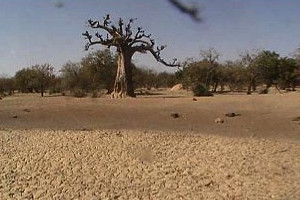 Etude technique d’avant-projet |
 Community-led WASH and Safe Motherhood |
Recharge des eaux souterraines : liens
- 3R Smart Solutions
- Africa Groundwater Literature Archive: il s’agit d’une base de données interrogeable regroupant des écrits publiés et non publiés sur les eaux souterraines en Afrique, dont des rapports, des articles de presse, des documents de conférence et des cartes. La plupart de ces ressources sont téléchargeables gratuitement ; pour les autres, un lien renvoie à un résumé en ligne, ou bien des références bibliographiques complètes sont fournies lorsqu’aucune version en ligne n’est disponible.
- Sustainable Development of Groundwater Resources in Southern and Eastern Africa. Agence internationale de l'énergie atomique (AIEA).
- Rainwater Harvesting and Utilisation. ou (autre lien). Blue Drop Séries : Livre 2 : Beneficiaries & Capacity Builders. UN-HABITAT.
- Managed Aquifer Recharge (MAR)
- Grand wiki sur l’emploi de l’eau dans l’agriculture : Agropedia
Remerciements
- Tuinhof, Albert and Heederik, Jan Piet. Management of Aquifer Recharge and Subsurface Storage ou (autre lien). Le Comité national néerlandais pour l’Association internationale d’hydrologistes (IAH) et la Société hydrologique néerlandaise. 2002.
- Aquifer Recharge (AR) and Aquifer Storage & Recovery (ASR). Agence américaine de protection de l’environnement (EPA).
- Management of Ground Water in Africa Including Transboundary Aquifers: Implications for Food Security, Livelihood and Climate Change Adaptation. Commission économique américaine pour l’Afrique, Centre de politique climatique africain, 2011.
- CARE Pays-Bas, bureau d’étude : Resilient WASH systems in drought-prone areas. Octobre 2010.


